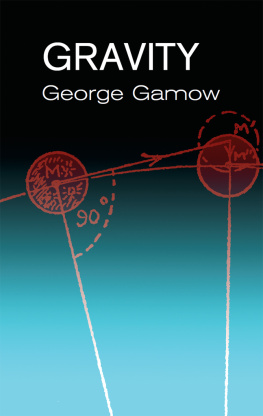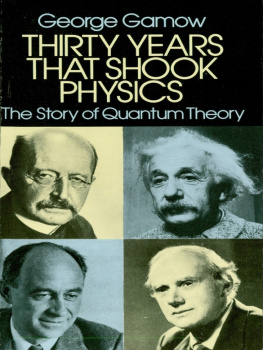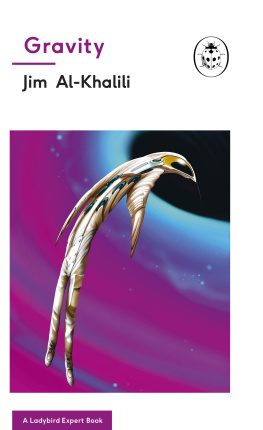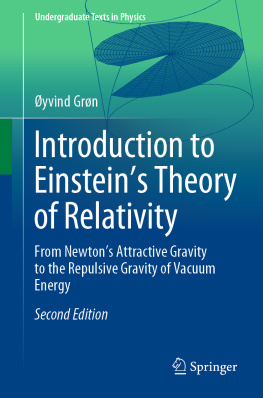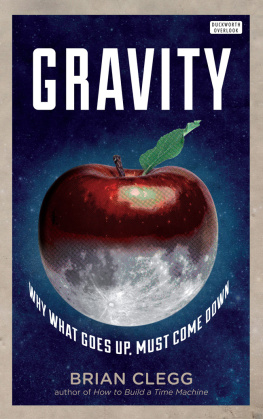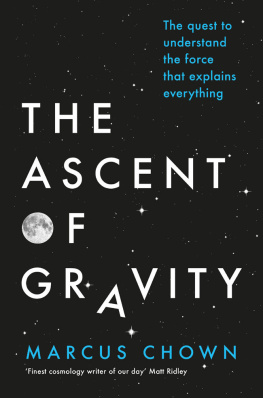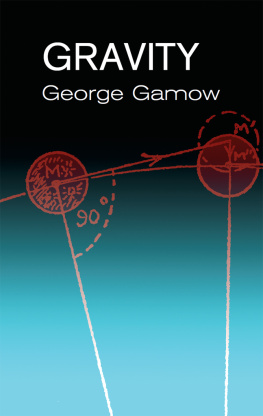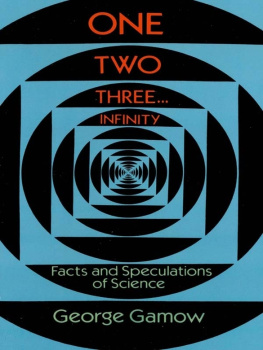GRAVITY
GEORGE GAMOW
Illustrations by the Author
DOVER PUBLICATIONS, INC.
Mineola, New York
Copyright
Copyright 2002 by Dover Publications, Inc.
All rights reserved.
Bibliographical Note
This Dover edition, first published in 2002, is an unabridged republication of the work originally published (as part of the Science Study Series) by Anchor Books, Doubleday & Company, Inc., Garden City, New York, in 1962. A new Preface has been specially prepared for this edition.
Library of Congress Cataloging-in-Publication Data
Gamow, George, 1904-1968.
Gravity / George Gamow ; illustrated by the author.
p. cm.
Originally published: Garden City, N.Y. : Anchor Books, 1962, in series: Science study series.
Includes bibliographical references and index.
ISBN-13: 978-0-486-42563-4 (pbk.)
ISBN-10: 0-486-42563-0 (pbk.)
1. Gravitation. I. Title.
QC178 .G3 2002
531.14dc21
2002034827
Manufactured in the United States by Courier Corporation
42563006
www.doverpublications.com
GRAVITY
BIOGRAPHY
In 1954 Dr. George Gamow, who had been specializing in the application of nuclear physics to problems in astrophysics and cosmology, made a mathematical suggestion about cell chemistry and thereby set a pattern for DNA research in genetics that has turned out to be quite valuable. This episode, in the telling of which one must mention nuclear physics, astrophysics, cosmology, mathematics, chemistry, and biology, is illustrative of Dr. Gamows many-faceted career in science but fails to do his versatility full justice. Literary critics in both the United States and England have acclaimed him the best living interpreter of science to the layman, have delighted in his scientific fantasies and discovered poetry in his writing. To secure a reputation in either science or literature ordinarily is accounted achievement enough for one man, but Dr. Gamow has not been satisfied with both. As readers of this little book will be privileged to see, Dr. Gamow also has tackled the fine arts, democratically drawing inspiration from both the Sunday comics and the masterpieces of Sandro Botticelli. (If at first glance you do not detect the Botticelli influence in Dr. Gamows portrait of the late Albert Einstein on , at least you have assurance from the artist himself that it is there.) And in all these separate fields of creativity, Dr. Gamow has been about equally prolific.
Dr. Gamow was born on March 4, 1904, in Odessa, Russia. In early youth he turned to science and spent a year studying paleontology. This experience, he said later, equipped him to tell a dinosaur from a cat by the shape of the little toes. He entered the University of Leningrad, from which he received a Ph.D. degree in 1928, and spent a year at the University of Gttingen, in Germany, on a traveling fellowship. In 1928-29 he worked with Niels Bohr in Copenhagen and in 1929-30 with Ernest Rutherford at the Cavendish Laboratory, Cambridge, England.
Dr. Gamow was twenty-four when he made his first major contribution to physical theory. Concurrently, but independently, he, on the one hand, and the American physicist E. U. Condon and the British physicist R. W. Gurney, on the other, explained the emission of alpha-particles from radioactive atoms by applying to the process the then new methods of wave mechanics. Two years later, in 1930, he made the successful prediction that protons would be more useful than alpha-particles in the experiments popularly known as atom-smashing, and in the same year he suggested the liquid drop model for the nuclei of heavy elements. In 1929 he collaborated with R. Atkinson and F. Houtermans in formulating the theory that the suns heat and light resulted from thermonuclear processes, and his theory of the origin of chemical elements through neutron capture dominated Cosmo-logical thinking at one period in the 1940s. His contribution to DNA theory was the suggestion that the four nucleotides of the DNA molecule compose a code whose different combinations act as templates in the organization of the various amino acid molecules.
Dr. Gamows personal characteristics are almost as formidable as his creative achievements. A giant, six feet three and well over 225 pounds, he is given to puckish humor, as readers of his Mr. Tompkins fantasies well know. When he and his student, R. Alpher, signed their names to the preliminary calculations of their paper, The Origin of Chemical Elements, in 1948, Gamow commented, Something is missing, and, crediting Hans Bethe in absentia, made the signature Alpher, Bethe and Gamow. He speaks six languages and is a frequent and popular lecturer with a heavily accented delivery that moved a friend to observe that the six languages were all different dialects of one languageGamovian.
His ability as a linguist, however accented, reflects the ground he has covered in his professional career. After his studies with Bohr and Rutherford, he returned to Russia as Master in Research at the Academy of Sciences in Leningrad but left his native land for good in 1933. He lectured in Paris and London, at the University of Michigan summer school, and then joined the faculty of George Washington University, Washington, D.C., where he was professor of physics from 1934 to 1956. He became a United States citizen in 1940 and acted as a Navy, Army, Air Force and Atomic Energy Commission consultant during and after World War II. Since 1956 he has been on the faculty of the University of Colorado, Boulder.
Dr. Gamow has written many technical papers and one technical book, Atomic Nucleus (Oxford University Press, 1931, revised 1937 and 1949). His popular writing includes numerous Scientific American articles and the following books:
Mr. Tompkins in Wonderland, Cambridge University Press, 1939
Mr. Tompkins Explores the Atom, Cambridge University Press, 1943
Mr. Tompkins Learns the Facts of Life, Cambridge University Press, 1953
Atomic Energy in Cosmic and Human Life, Cambridge University Press, 1945
The Birth and Death of the Sun, Viking Press, 1941
Biography of the Earth, Viking Press, 1943
One, Two, Three... Infinity, Viking Press, 1947
Creation of the Universe, Viking Press, 1952
Puzzle-Math (with M. Stern), Viking Press, 1958
The Moon, H. Schuman, 1953
Matter, Earth and Sky, Prentice Hall, 1958
Physics: Foundation and Frontiers (with J. Cleveland), Prentice Hall, 1960
Atom and Its Nucleus, Prentice Hall, 1961
Biography of Physics, Harper and Brothers, 1961
He took up illustrating for the second Mr. Tompkins book when World War II interrupted communication between him and the English artist who had worked with him on the earlier book of the series. In 1956 he received the Kalinga Prize from UNESCO for his popular interpretations of science for lay readers.
Dr. Gamow was a member of the Academy of Science of the U.S.S.R. until, as he says, he was fired after leaving Russia. He is a member of the Royal Danish Academy of Sciences and the National Academy of Sciences of the United States.
PREFACE TO THE DOVER EDITION
George Gamow (pronounced Gam-off) was a first-rate scientist who is credited with major advances in nuclear physics and cosmogenesis. But, as the preceding biographical note indicates, he was equally well known, at the time of his death in 1968, for his lucid, lively interpretations of science for the layperson. According to a grateful reporter who sought Gamows help in understanding the physics behind the Bikini H-bomb test in 1949, He can always take the most technical information and make it simple. Another journalist at that cataclysmic event declared that Gamow was the only scientist in America with a real sense of humor. Both of these traits come through in Gamows writing, and a surprising number of scientistsincluding more than one Nobel laureatehave credited his books with having stimulated their childhood interest in science. Gamow delighted readers with his series of insidiously informative books featuring the timid but curious bank clerk C. G H. Tompkins, with his

